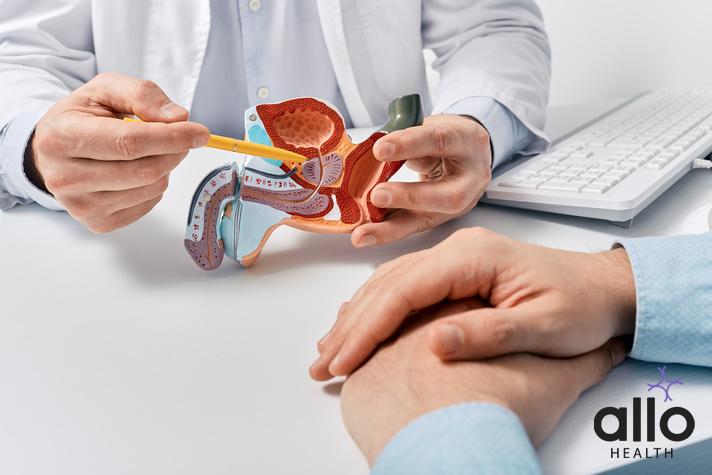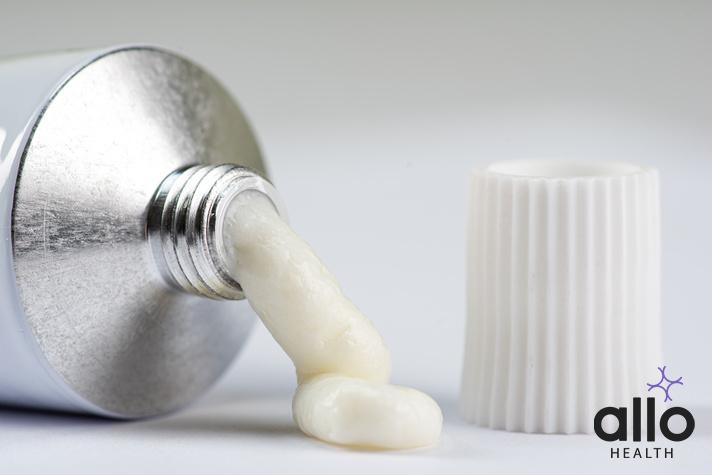White Ring Around Foreskin: Causes and Treatment

"The following blog article may discuss medical treatments and interventions. However, it is important to note that the information provided is for general educational purposes only and should not be considered as a substitute for professional medical advice, diagnosis, or treatment. Always seek the guidance of a qualified healthcare professional for personalized medical advice.
Book consultation
Medical treatments are complex and should be tailored to individual circumstances. The information presented in this blog may not be applicable to everyone, as each person's medical condition, history, and needs are unique. Only a qualified healthcare professional can evaluate your specific medical situation, consider relevant factors, and provide appropriate recommendations for diagnosis, treatment options, and monitoring.
It is crucial to note that self-diagnosis, self-medication, or relying solely on the information provided in this blog for treatment decisions can have serious health consequences. "
The presence of white ring around the foreskin can be concerning for individuals experiencing this condition. While it may raise worries about serious medical conditions, understanding the underlying causes and available treatments is essential for proper management. This article aims to explore the causes, accompanying symptoms, and treatment options for white ring around the foreskin.
What is Foreskin and It’s Different Complications?
The foreskin, also known as the prepuce, is the retractable fold of skin that covers the head (glans) of the penis in uncircumcised males. While it serves various purposes, including protecting the sensitive glans and maintaining moisture, it can be prone to several complications:
Phimosis:
- Pathologic Phimosis: Tightening of the foreskin to the extent that it cannot be retracted, leading to potential concerns like poor hygiene and bacterial infections.
- Physiologic Phimosis: Normal in infants and young boys, where the foreskin is naturally tight but should gradually become retractable with age.
Balanitis:
- Balanitis Xerotic: Inflammation of the glans penis and foreskin due to poor hygiene, leading to white patches or spots.
- Circinate Balanitis: Characterized by flesh-colored bumps on the glans, often associated with underlying conditions like lichen planus.
Infections:
- Bacterial Infections: Resulting from poor hygiene practices, leading to discomfort, itching, and possible white rings or patches.
- Fungal Infections: Such as candidiasis, causing white spots and requiring antifungal creams for treatment.
Understanding these complications is vital for maintaining proper penile health, promoting hygiene practices, and seeking medical attention when necessary to prevent further complications like scar tissue formation or surgical intervention.
What are White Rings Around Foreskin Means?
- White rings around the foreskin typically indicate underlying concerns such as tight foreskin or skin conditions like balanitis xerotic or lichen sclerosus. These rings may appear due to poor hygiene, bacterial or fungal infections, or physiological factors like pathologic phimosis.
- They manifest as visible white patches or spots on the foreskin, often accompanied by symptoms like itching, discomfort, or foreskin pain. Differential diagnosis involves assessing for associated skin conditions, distinguishing between physiological and pathological phimosis, and evaluating clinical history.
- Treatment involves improving hygiene practices, using medication such as topical steroid creams or antifungal agents, and seeking medical attention if symptoms persist. In severe cases, surgical procedures like circumcision or surgical removal of scar tissue may be necessary. Prompt intervention can alleviate symptoms and prevent complications associated with foreskin concerns and skin conditions.
Causes of White Rings Around Foreskin
The causes of white rings around the foreskin vary, often stemming from several factors:
- Poor Hygiene: Inadequate cleaning of the penis can lead to the accumulation of dead skin cells and bacteria under the foreskin, resulting in white spots or patches.
- Skin Infections: Bacterial or fungal infections, such as balanitis or genital warts caused by viral infections like genital herpes, can manifest as white rings or spots on the foreskin.
- Medical Conditions: Conditions like balanitis xerotic or lichen sclerosus can also cause white patches on the foreskin due to inflammation or changes in the skin’s appearance.
- Tight Foreskin: Pathologic phimosis, where the foreskin cannot be retracted due to tightness, may predispose individuals to skin concerns and white ring formation.
- Inflammation: Chronic inflammation of the foreskin, whether from infections or skin conditions, can result in the development of white rings or spots due to changes in the skin’s texture and color.
Understanding these underlying causes is crucial for proper diagnosis and effective treatment of white rings around the foreskin, ensuring optimal genital health and preventing potential complications.
Other Accompanying Symptoms
Commonly accompanied symptoms along with white rings around the foreskin include:
- Itchy or Painful Spots: Individuals may experience discomfort or itching in the affected area, indicating irritation or inflammation caused by the white rings.
- Foreskin Pain: Painful sensations during retraction or erections can occur, especially in cases of tight foreskin (pathologic phimosis) or underlying skin conditions like balanitis xerotic or lichen sclerosus.
- Discolored Penis Head: The presence of white rings may cause the penis head to appear discolored, with noticeable white patches or spots, indicating potential skin concerns or infections.
- Flesh-Colored Bumps: In some cases, flesh-colored bumps or lesions may accompany the white rings, signaling the presence of genital warts or other viral infections like genital herpes.
- Chronic Symptoms: Persistent or recurring symptoms despite attempts at hygiene or over-the-counter products may indicate the need for medical attention, as underlying conditions such as lichen sclerosus or chronic balanitis may be present.
Recognizing these symptoms alongside white rings around the foreskin is crucial for prompt diagnosis and appropriate treatment to alleviate discomfort and prevent complications. Seeking medical advice is advisable for proper evaluation and management of the condition.
Complications Due to White Rings Around Foreskin

Complications arising from white rings around the foreskin can vary depending on the underlying cause and severity of the condition:
- Infections: Bacterial or fungal infections can worsen if left untreated, leading to further discomfort, inflammation, and potential spread to surrounding genital tissues.
- Skin Conditions: Conditions like balanitis or lichen sclerosus can cause chronic symptoms such as itching, pain, and the development of scar tissue, affecting the overall health and appearance of the genital skin.
- Phimosis Complications: Persistent tightness of the foreskin (pathologic phimosis) can impede proper hygiene, leading to an increased risk of infections, irritation, and inflammation. In severe cases, painful erections or difficulty urinating may occur.
- Psychological Impact: Persistent discomfort and embarrassment associated with the condition can affect an individual’s self-esteem and sexual confidence, leading to psychological distress and relationship concerns.
- Potential for Penile Cancer: While rare, untreated chronic inflammation or infections may increase the risk of developing certain types of penile cancer, emphasizing the importance of proper diagnosis and treatment.
Early intervention and proper treatment are essential to prevent complications and promote overall genital health. Seeking medical attention for persistent symptoms or concerns is crucial in managing and preventing complications associated with white rings around the foreskin.
Diagnostic Process Due to White Rings Around Foreskin
Clinical Examination:
- A medical professional examines the affected area for white patches, inflammation, or other abnormalities.
- They inquire about the patient’s medical history, including any previous skin conditions or infections.
Differential Diagnosis:
- Differentiating between physiologic and pathologic phimosis to determine the underlying cause.
- Assessing for associated skin conditions such as balanitis xerotic or lichen sclerosus.
Laboratory Tests:
- Blood tests, including complete blood count, may be ordered to check for signs of infection or inflammation.
- Swabs or cultures may be taken from the affected area to identify specific pathogens causing the white rings.
Biopsy (if necessary):
- In cases where the diagnosis is unclear or if there is suspicion of a more serious condition like penile cancer, a biopsy may be performed.
- This involves removing a small piece of tissue from the affected area for further examination under a microscope.
Discussion and Follow-Up:
- Based on the findings, the healthcare provider discusses treatment options and recommendations with the patient.
- Follow-up appointments may be scheduled to monitor progress and adjust treatment as needed.
Treatment Options

Treatment options for white rings around the foreskin vary based on the underlying cause and severity of the condition:
- Topical Steroid Creams: Applying medications like fluticasone propionate can help reduce inflammation and alleviate symptoms associated with conditions like balanitis xerotic or lichen sclerosus.
- Antifungal Creams: For fungal infections causing white patches, antifungal creams containing active ingredients such as clotrimazole or miconazole are effective in treating the underlying infection.
- Prescription Medications: In cases where bacterial infections are present, antibiotics prescribed by a healthcare provider can target the underlying infection and promote healing.
- Acid-Based Creams: Certain skin conditions like lichen sclerosus may benefit from acid-based creams, which help restore the skin’s pH balance and alleviate symptoms.
- Surgical Procedures: In severe or persistent cases, surgical intervention may be necessary. This could involve surgical removal of scar tissue, circumcision, or other procedures to address underlying concerns causing the white rings.
Consulting a Medical Professional: Seeking advice from a healthcare provider is essential for proper diagnosis and treatment. They can provide personalized recommendations based on the individual’s medical history and the specific condition causing the white rings.
Preventive Measures
Preventive measures for white rings around the foreskin focus on maintaining proper hygiene and addressing potential underlying causes:
Daily Hygiene Routine:
- Clean the penis regularly with gentle soap and water to remove dead skin cells and prevent bacterial or fungal overgrowth.
- Avoid harsh soaps or irritants that can exacerbate skin conditions like balanitis xerotic or lichen sclerosus.
Gentle Retraction:
- Gradually retract the foreskin daily to prevent adhesion and promote proper cleaning.
- Avoid forceful foreskin retraction, which can cause tears and scarring, leading to pathologic phimosis.
Medical Attention:
- Seek medical advice if noticing any changes in the appearance or texture of the foreskin.
- Regular check-ups with a healthcare provider can help monitor for any signs of infection or skin conditions.
Proper Treatment of Infections:
- Promptly treat any bacterial or fungal infections with appropriate medications prescribed by a medical professional.
- Follow prescribed treatment regimens to ensure complete resolution and prevent recurrence.
Avoidance of Irritants:
- Use latex-free condoms if latex sensitivity is suspected to prevent irritation and inflammation.
- Steer clear of potential skin irritants and allergens that may exacerbate existing conditions.
By implementing these preventive measures, individuals can minimize the risk of developing white rings around the foreskin and promote overall genital health.
Conclusion
While a white ring around the foreskin can be distressing, it’s crucial to address it promptly with proper treatment. Understanding the underlying causes, maintaining good hygiene practices, and seeking medical attention when necessary are essential steps towards managing this condition effectively. With the right approach, individuals can alleviate symptoms and prevent complications associated with foreskin concerns and skin conditions.
Most Asked Questions
-
What causes a white ring around the foreskin?
A white ring around the foreskin can be caused by factors like poor hygiene, skin infections (bacterial or fungal), or certain medical conditions such as balanitis xerotic or lichen sclerosus.
-
How can I tell if I have a white ring around my foreskin?
Look out for visible white patches or spots on the foreskin, along with symptoms like itching, discomfort, or pain during retraction or erections. If you notice any of these signs, it’s essential to seek medical advice for proper diagnosis and treatment.
-
What can I do to treat a white ring around my foreskin at home?
Improving hygiene practices by gently cleansing the penis with mild soap and water daily can help. Additionally, gradual retraction of the foreskin and avoiding harsh soaps are recommended. However, if symptoms persist or worsen, it’s important to consult a medical professional for further evaluation and treatment.
-
When should I seek medical attention for a white ring around my foreskin?
If you experience persistent symptoms, such as white patches, itching, or pain, despite home care efforts, or if you notice any changes in the appearance of the foreskin, it’s advisable to seek medical attention. A healthcare provider can provide a proper diagnosis and recommend appropriate treatment options tailored to your specific condition.







































